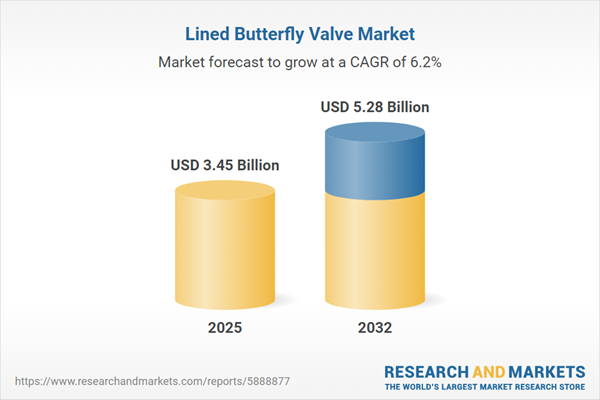Speak directly to the analyst to clarify any post sales queries you may have.
Senior decision-makers are reevaluating fluid control strategies, compelled by increasing regulatory demands and operational complexity. Effective integration of lined butterfly valves has become a cornerstone for achieving reliability, safety, and compliance in highly regulated industries.
Lined Butterfly Valve Market Snapshot
The global lined butterfly valve market is valued at USD 3.25 billion and is projected to reach USD 5.28 billion by 2032, advancing at a compound annual growth rate (CAGR) of 6.24%. Growth stems from rising needs in chemicals, petrochemicals, power generation, and water management, sectors where advanced fluid control is mission-critical. As procurement practices increasingly respond to evolving regulatory pressures, businesses place heightened focus on selecting equipment capable of sustaining performance in challenging and dynamic environments. Technical upgrades and an emphasis on lifecycle management are shaping investment decisions, ensuring both reliability and competitive agility in today's fast-evolving market.
Scope & Segmentation: Lined Butterfly Valve Market
- Lining Materials: Engineered linings such as EPDM, Neoprene, PFA, and PTFE are deployed to enhance resistance to chemical exposure and abrasion, ensuring reliability and lowering maintenance demands in fluid-intensive operations.
- Valve Sizes: Variants under 50 mm target specialized or compact installations, while models exceeding 200 mm are tailored for high-volume and industrial-scale applications—a spectrum ensuring operational fit across multiple sectors.
- Body Materials: Carbon steel, stainless steel, cast iron, and ductile iron options address a variety of mechanical and environmental challenges, supporting application flexibility from routine to highly demanding operating conditions.
- End Users: Chemical processing, oil and gas, utilities, pharmaceuticals, and food and beverage industries rely on lined butterfly valves for regulated flow and system integrity across critical processes and infrastructure.
- Applications: Use cases span hazardous fluid handling, slurry transport, gas and steam conveyance, and water treatment, supporting continuous operation while mitigating safety and process risks.
- Regional Coverage: North America and Europe show ongoing modernization and regulatory initiatives. Asia-Pacific leads with infrastructure-driven demand, while the Middle East and Africa are adopting newer technologies to advance industrial output and improve operational standards.
- Key Companies: Market leaders such as Emerson Electric Co., Flowserve Corporation, Crane Co., IMI plc, Velan Inc., KSB SE & Co. KGaA, Bray International Inc., SAMSON AG, Val-Matic Valve & Manufacturing Corp., and AVK Holding A/S are investing in automation and support services to meet evolving customer needs globally.
Lined Butterfly Valve Market: Key Takeaways for Senior Leaders
- Advanced polymer linings and seals equip valves for long-term functionality in chemically aggressive or high-temperature applications, helping organizations meet growing compliance and process stability requirements.
- Adoption of digital monitoring and smart valve platforms enables predictive maintenance and faster identification of performance issues, strengthening asset oversight and minimizing unforeseen downtime.
- Procurement and certification processes are streamlined by standardized documentation, accelerating qualification for capital projects and simplifying compliance management tasks.
- Embedded automation and diagnostics support operator confidence, improving safety outcomes and enhancing risk management across demanding, continuous operations.
- Regional investment patterns shift market dynamics, with growth fueled by Asia-Pacific infrastructure programs and evolving purchasing criteria in North American and European regulatory settings.
- Collaboration between manufacturers, material providers, and end users is central to delivering solutions aligned with current industry expectations and evolving specifications.
Tariff Impact: Managing Cost and Supply Chain Pressures
Recent tariff adjustments in the United States are increasing raw material costs for manufacturers within the lined butterfly valve market. Response strategies have included diversifying supplier bases, pursuing vertical integration, and forming deeper relationships with domestic partners. These approaches are reinforcing the resilience of the supply chain and supporting consistent delivery performance amid market uncertainties.
Market Research Methodology & Data Sources
This market analysis utilizes executive interview insights, expert consultations, and a systematic review of authoritative industry publications and regulatory updates. Rigorous validation with sector stakeholders ensures the information remains actionable for senior leadership and aligns with current priorities in the lined butterfly valve market.
Why This Report Matters
- Delivers comprehensive analysis of regulatory changes and technological advancements, providing leaders with valuable input for effective strategy formulation.
- Supports supply chain and procurement teams in identifying emerging challenges and adapting sourcing strategies within a continually evolving trade landscape.
- Equips decision-makers with actionable insights for capturing growth opportunities and reinforcing compliance throughout process control investments.
Conclusion
Lined butterfly valves remain integral to managing increasingly complex process environments and meeting new regulatory standards. This report assists leaders in aligning technology decisions with organizational objectives to drive operational efficiency and compliance.
Additional Product Information:
- Purchase of this report includes 1 year online access with quarterly updates.
- This report can be updated on request. Please contact our Customer Experience team using the Ask a Question widget on our website.
Table of Contents
3. Executive Summary
4. Market Overview
7. Cumulative Impact of Artificial Intelligence 2025
Companies Mentioned
The companies profiled in this Lined Butterfly Valve market report include:- Emerson Electric Co.
- Flowserve Corporation
- IMI PLC
- Crane Co.
- Velan Inc.
- KSB SE & Co. KGaA
- Bray International, Inc.
- SAMSON AG
- Val-Matic Valve & Manufacturing Corp.
- AVK Holding A/S
Table Information
| Report Attribute | Details |
|---|---|
| No. of Pages | 190 |
| Published | November 2025 |
| Forecast Period | 2025 - 2032 |
| Estimated Market Value ( USD | $ 3.45 Billion |
| Forecasted Market Value ( USD | $ 5.28 Billion |
| Compound Annual Growth Rate | 6.2% |
| Regions Covered | Global |
| No. of Companies Mentioned | 11 |









